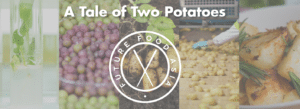By Nadine Freischlad
A TALE OF TWO POTATOES
The humble potato has many quirks. For one, it’s surprisingly complicated to grow at commercial scale. But new technology is about to change that. A Korean company E Green Global (EGG) developed a new process for creating seed potatoes. Instead of taking several years to grow them from a stem – which is the conventional way – EGG’s seed potatoes are ready to be planted after two years. This innovation has the potential to rewrite the story of how a potato gets onto your plate.
THE OLD POTATO STORY
Let’s rewind some 170 years. In the 1850s, farmers in Ireland found the potatoes in their fields were refusing to grow. They had caught a disease. That year, the harvest was very poor, and the following years weren’t better. Potatoes had become so important to the Irish diet that their absence was causing a devastating famine. Hundreds of thousands of Irish migrated to America, coincidentally the continent where humans had first started cultivating potatoes millennia ago.
Europe had only relatively recently come to develop a taste for the nutritious tubers. It’s not well understood how potatoes first got to Europe, but early records of potato trade within Europe are from the 16th century. It’s believed to have been widespread across the continent by the 18th century.
To cultivate potatoes, theoretically, you can take a bundle, let them sprout and plant them in the ground. The potatoes that grow are genetically identical to the ones you planted, because this is a form of vegetative propagation. Replant those potatoes again, and you have another set of identical offspring. This wouldn’t be an issue, if potatoes weren’t so prone to disease. The Great Potato Famine that led to mass migration more than a century ago was most likely caused by a type of mold that’s much easier to treat nowadays. But growing potatoes at commercial scale remains problematic.
What’s known about potatoes today is that many of them carry viruses, explains Keejoon Shin, an economics major who became a potato expert because he saw a potential for innovation in the way this crop is grown. He was working in the biotech industry in Korea and set out to start his own company, EGG.
“Potatoes are susceptible to over 30 viruses,” he says. These are transmitted by insects. “Once they bite stems or leaves, the plant gets infected. The virus also enters the tubers.” Potato viruses are not dangerous for humans, but they affect the health and growth rate of the potato itself. If you keep replanting the same potato, the virus extends to that new crop and becomes even more widespread, until most plants are affected. Yields keep diminishing.
Hence, re-planting potatoes from one season to the next isn’t what happens in commercial potato farming. Farmers rely on so-called seed potatoes. These are grown under special conditions to be guaranteed virus free, in a separate process.
Seed potato production conventionally starts with a meristem, the tip of the sprout from a potato. That’s taken out and grown in a lab. When the stem grows, you cut it in half, which creates more stems. Only once this has been repeated several times the stems are planted in soil, where it forms tubers. This first generation of potatoes is multiplied by just taking a bundle and replanting, but under the same controlled conditions as the meristem cultivation. This goes on for several seasons. It takes six years before enough virus-free seed potatoes have formed from one stem for them to be sold to conventional farmers.
The process is tedious, but necessary. “It’s so important to have clean seed,” says Keejoon. But it has concentrated the production of seed potatoes in the hands of a few. Humans only realised there are viruses in potatoes roughly 100 years ago, and efforts to produce virus free potatoes started even more recently. As a result, Keejoon explains, only a few countries in the world have a system for growing seed potatoes; countries with advanced agricultural industries, like the US and the Netherlands.
Potato yields in most other countries remain low because there’s a lack of healthy seed potatoes. Poor countries without seed potato production sometimes have to rely on importing them from overseas, but another of the plants quirks complicate this. Most staple foods like rice, wheat, and maize, consist of grains that are dense, dry, and tiny. They can be produced by some countries en masse and shipped anywhere for cheap. Not so the potato. Tubers are heavy and contain a lot of water. It doesn’t make sense to ship them long distance. They also can’t be stored for very long.
That’s why most countries produce their potatoes domestically. “There’s less international trade with potatoes than other crops,” says Keejoon. It’s mostly seed potatoes that get shipped, if at all. And remember, seed potatoes take many generations until they are ready to go to market. If you want to introduce a new variety in another country, this takes years and years.
THE NEW POTATO STORY
Today, the whole world eats potato. They are number four after those top staple foods mentioned above, that can whisked across continents: rice, wheat, and maize. Emerging economies with big populations like China and India have started eating more potato, forming a huge market.
It’s not that potatoes are replacing rice, which is so common throughout most of Asia.People are simply eating more, and they want more choice. The proliferation of fast food chains like McDonalds has a role in driving this trend. Urbanisation and more affluent middle classes are creating a market for french fries. On the other end of the spectrum, rural poor are also consuming more potatoes because they provide more complete nutrition than rice.
But in the developing world local potato production isn’t yet delivering at its full potential. Efforts to develop a seed potato production process at scale in China, for example, haven’t yet been effective. “China is showing a 17 tonne per hectare yield, meanwhile the US achieves three times that,” says Keejoon.
Keejoon and his team at EGG, the company he co-founded in 2009 have found a way to shortcut and standardise seed potato production in a closed lab environment. After many years of R&D and trials their company now can deliver virus-free seed potatoes in a new and faster process.
“We still do meristem culture, but instead of bringing the stems to a greenhouse, we bring them to a dark room and induce tuberization. This requires a growing media, we don’t use soil,” Keejoon explains. The resulting microtubers are pea-sized, and they grow all year round. Instead of having to wait 6 years for enough seed potatoes to form, EGG’s process can deliver in two years.
The innovation isn’t the tuberization under lab conditions per se. “This wasn’t invented by us, it’s been there for a long time,” Keejoon says. It just was never commercially successful, because the resulting microtubers were too weak and unproductive when planted.
EGG’s process gives the microtubers more time to mature, and it succeeds in making healthier microtubers, which can be directly planted. They’re full of starch, which means they have a lot of energy to grow.
But figuring out how to grow microtubers with higher dry matter contents than previous ones still wasn’t the end of the challenge. “When we founded the company, step one, growing the microtubers, was done. Then it took us more than six years to develop the cultivation protocol,” Keejoon says. A cultivation protocol gives farmers recommendations for things like ideal soil conditions, temperature, and humidity, so the plants can grow optimally.
The company has been operating commercially for five years, but a full understanding of the cultivation protocol only took shape around two years ago. EGG is currently already working with China’s largest state-owned agriculture company. “They are very supportive,” says Keejoon. EGG has planted 4 million microtubers in one place. Potential customers for the technology are mostly large scale industrial farmers, but smallholder farmers can also benefit from having an alternative source from which to buy high-quality seed potato. “Our goal is to give them good seeds, at a competitive price,” says Keejoon. The firm plans to open microtuber production facilities in other countries as well.
The best part is that the process works with any potato variety, which means EGG can produce seeds for rare local varieties on demand at one of their facilities and ship them. According to Keejoon, EGG can do this profitably even in small batches. Whether it’s helping boost yields on large-scale farms in China, or helping farmers in Sri Lanka preserve native varieties, EGG has the game-changing potential to bring more diversity, and more profitable potato growing practices to farmers and consumers around the world.

